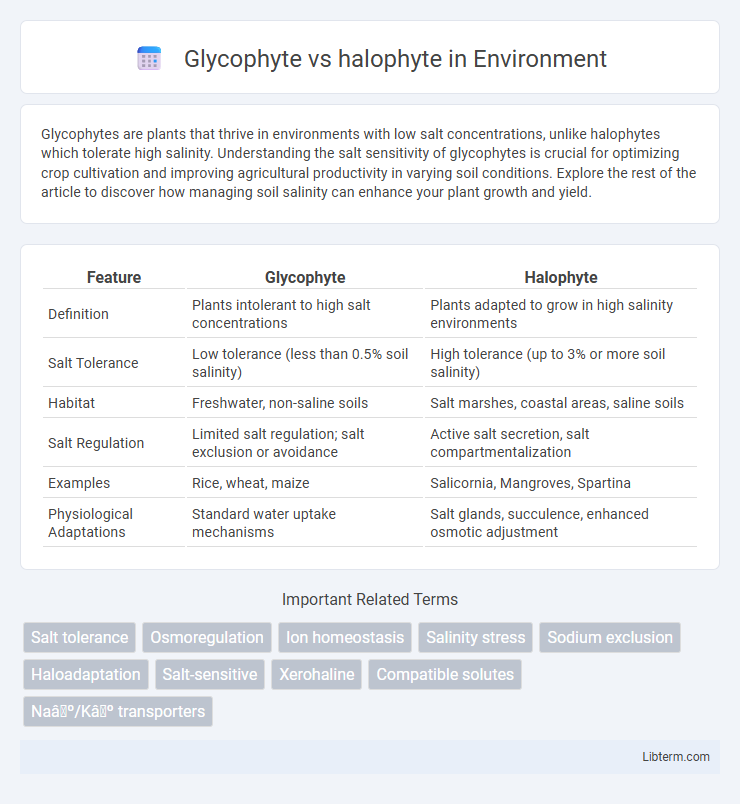Glycophytes are plants that thrive in environments with low salt concentrations, unlike halophytes which tolerate high salinity. Understanding the salt sensitivity of glycophytes is crucial for optimizing crop cultivation and improving agricultural productivity in varying soil conditions. Explore the rest of the article to discover how managing soil salinity can enhance your plant growth and yield.
Table of Comparison
| Feature | Glycophyte | Halophyte |
|---|---|---|
| Definition | Plants intolerant to high salt concentrations | Plants adapted to grow in high salinity environments |
| Salt Tolerance | Low tolerance (less than 0.5% soil salinity) | High tolerance (up to 3% or more soil salinity) |
| Habitat | Freshwater, non-saline soils | Salt marshes, coastal areas, saline soils |
| Salt Regulation | Limited salt regulation; salt exclusion or avoidance | Active salt secretion, salt compartmentalization |
| Examples | Rice, wheat, maize | Salicornia, Mangroves, Spartina |
| Physiological Adaptations | Standard water uptake mechanisms | Salt glands, succulence, enhanced osmotic adjustment |
Introduction to Glycophytes and Halophytes
Glycophytes are plants adapted to grow in low-salinity environments, exhibiting sensitivity to high salt concentrations, which can inhibit their growth and physiological processes. Halophytes thrive in high-salinity habitats such as salt marshes and coastal regions, possessing specialized mechanisms like salt excretion and succulence to tolerate and manage salt stress. Understanding the contrasting adaptations and salt tolerance strategies of glycophytes and halophytes is essential for agricultural development and environmental management in saline-prone areas.
Definition and Classification
Glycophytes are plants that thrive in low-salinity environments, exhibiting sensitivity to high salt concentrations, and are classified primarily under terrestrial vegetation. Halophytes, on the other hand, are salt-tolerant plants adapted to saline habitats such as salt marshes and coastal regions, classified within specialized ecological groups based on their salt tolerance mechanisms. These classifications are essential for understanding plant adaptation strategies and managing saline soil impacts on agriculture.
Key Differences in Salt Tolerance
Glycophytes are plants that exhibit low salt tolerance, thriving primarily in environments with minimal salinity, as their physiological processes are disrupted by high sodium ion concentrations. Halophytes adapt to saline conditions through specialized mechanisms such as salt ion compartmentalization, salt excretion glands, and enhanced osmotic regulation, enabling survival in habitats like salt marshes and coastal regions. The key difference lies in the ability of halophytes to maintain cellular ion homeostasis and mitigate salt-induced oxidative stress, while glycophytes generally suffer growth inhibition and ion toxicity under similar conditions.
Morphological Adaptations
Glycophytes exhibit morphological adaptations such as thin cuticles, large stomata, and shallow root systems that enable efficient water uptake in low-salinity environments. Halophytes possess specialized structures like salt glands, succulent leaves, thick cuticles, and extensive root systems designed to manage high salinity and minimize water loss. These contrasting adaptations reflect their survival strategies in freshwater versus saline habitats.
Physiological Mechanisms
Glycophytes maintain cellular homeostasis under salt stress through selective ion transporters that exclude excessive sodium and accumulate potassium, minimizing ionic toxicity. Halophytes employ specialized physiological mechanisms such as salt secretion glands and vacuolar compartmentalization to sequester high concentrations of sodium ions, enabling survival in saline environments. Both plant types regulate osmolyte synthesis and antioxidant enzyme activity to mitigate osmotic stress and oxidative damage caused by salinity fluctuations.
Ecological Distribution
Glycophytes predominantly inhabit terrestrial ecosystems with low soil salinity, thriving in forests, grasslands, and agricultural lands where freshwater availability supports their growth. Halophytes are specialized plants adapted to saline environments such as coastal marshes, salt flats, and tidal zones, where they tolerate or require high salt concentrations for survival. The contrasting ecological distribution of these plants underscores their evolutionary adaptations to freshwater versus saline habitats, influencing their role in ecosystem biodiversity and soil chemistry.
Examples of Glycophytes and Halophytes
Glycophytes include common crops such as rice (Oryza sativa), wheat (Triticum aestivum), and maize (Zea mays), which thrive in low-salinity soils and are sensitive to salt stress. Halophytes, like Salicornia europaea (common glasswort), Spartina alterniflora (smooth cordgrass), and Atriplex species (saltbush), are adapted to high-salinity environments, often found in coastal salt marshes and saline deserts. These plants exhibit specialized salt tolerance mechanisms allowing survival and growth in saline or sodic soils where glycophytes would fail.
Importance in Agriculture and Ecology
Glycophytes, which are salt-sensitive plants, dominate global agriculture by thriving in low-salinity soils and supporting staple crop production such as rice, wheat, and maize. Halophytes, salt-tolerant plants found in saline environments, play a crucial ecological role in stabilizing coastal and saline soil ecosystems, enhancing biodiversity, and offering potential for sustainable agriculture in salt-affected lands. Understanding the distinct adaptive mechanisms of glycophytes and halophytes is essential for developing salt-resistant crop varieties and improving land use in areas impacted by soil salinization.
Challenges and Opportunities in Cultivation
Glycophytes face significant challenges in saline soils due to their low salt tolerance, causing reduced growth and yield, while halophytes thrive in high salinity environments by utilizing specialized ion regulation mechanisms. The cultivation of halophytes offers opportunities for reclaiming saline lands and producing salt-tolerant crops, enhancing food security in arid and coastal regions. Developing salt-tolerant glycophyte varieties through genetic engineering and breeding programs presents a promising approach to overcoming salinity stress in traditional agriculture.
Future Research Directions
Future research on glycophytes and halophytes should emphasize genetic and molecular mechanisms underlying salt tolerance to enable crop improvement in saline environments. Advancements in genome editing, such as CRISPR-Cas9, offer promising tools to introduce salt-tolerance traits from halophytes into glycophyte crops. Investigating the microbiome interactions and metabolomic responses of both plant types can provide novel insights for sustainable agriculture under increasing soil salinization.
Glycophyte Infographic

 libterm.com
libterm.com